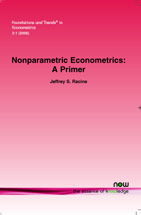Nonparametric Econometrics: A Primer
By Jeffrey S. Racine, Department of Economics, McMaster University, racinej@mcmaster.ca
Abstract
This review is a primer for those who wish to familiarize themselves with nonparametric econometrics. Though the underlying theory for many of these methods can be daunting for some practitioners, this article will demonstrate how a range of nonparametric methods can in fact be deployed in a fairly straightforward manner. Rather than aiming for encyclopedic coverage of the field, we shall restrict attention to a set of touchstone topics while making liberal use of examples for illustrative purposes. We will emphasize settings in which the user may wish to model a dataset comprised of continuous, discrete, or categorical data (nominal or ordinal), or any combination thereof. We shall also consider recent developments in which some of the variables involved may in fact be irrelevant, which alters the behavior of the estimators and optimal bandwidths in a manner that deviates substantially from conventional approaches.
Nonparametric Econometrics
Nonparametric Econometrics is a primer for those who wish to familiarize themselves with nonparametric econometrics. While the underlying theory for many of these methods can be daunting for practitioners, this monograph presents a range of nonparametric methods that can be deployed in a fairly straightforward manner.
Nonparametric methods are statistical techniques that do not require a researcher to specify functional forms for objects being estimated. The methods surveyed are known as kernel methods, which are becoming increasingly popular for applied data analysis. The appeal of nonparametric methods stems from the fact that they relax the parametric assumptions imposed on the data generating process and let the data determine an appropriate model.
Nonparametric Econometrics focuses on a set of touchstone topics while making liberal use of examples for illustrative purposes. The author provides settings in which the user may wish to model a dataset comprised of continuous, discrete, or categorical data (nominal or ordinal), or any combination thereof. Recent developments are considered, including some where the variables involved may in fact be irrelevant, which alters the behavior of the estimators and optimal bandwidths in a manner that deviates substantially from conventional approaches.
